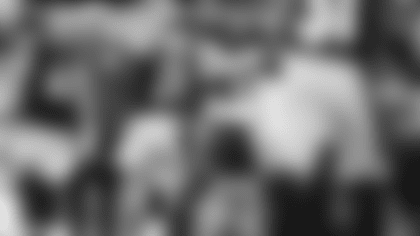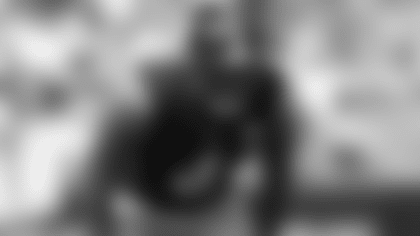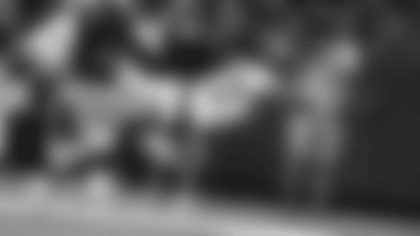Q. Early in your coaching career here, you seemed to prefer the "bell cow" approach to your running backs, which means one player at the position received the bulk of the carries unless injured. This season a more 1-2 punch style has been used with Najee Harris and Jaylen Warren involved in a more equal sharing of playing time and touches. Why the apparent change in approach?
A. To me it's about utilizing the tools we have at our disposal. When you have red paint, as Kevin Colbert used to say, you paint your barn red. We have two really capable runners. Positions aside, they're two of the most capable guys within our offense. And so we want to utilize both in an effort to engineer victory.
Q. Last week, you mentioned Najee Harris as one of the offensive leaders, and in previous shows you have talked about his competitiveness in terms of being from the Bay Area and flying over a lot of quality programs to go to Tuscaloosa, Alabama, to take on the challenges there. In your mind, what makes him worth the No. 1 pick that was used to bring him here?
A. His talents. His demeanor. Just look at our history, or the recent history. Le'Veon Bell, James Conner. Prior to them, obviously, you know the history. We value the high-end, big runners for this time of year. There's a reason why we're always making a push over the second half of the year. We play behind our big people in our run game. As the attrition component of the season becomes a factor, we believe that it is a strength of ours. It is a strength of his. He's been a bell cow. He carried the bulk of the load his last year at Alabama through a 13-14 game schedule. I knew he was built for that. I wasn't guessing. In mentality I know he's built for it. And so those are just some of the reasons.
Q. You mentioned demeanor. What is his demeanor?
A. He wants it. It's as simple as that. Sometimes people can have a skill-set, but it's that "will" component, that intangible quality that we're all trying to measure. When you know somebody has it, that's good information for you.
Q. Have you ever gotten any pushback from him about not being the "bell cow?"
A. Again, he went to Alabama. Think about the guys he played with at running back at Alabama. I mean, he was in a crowded backfield for most of his career. His last year there is really the only year where he was "the guy." But he played with Josh Jacobs and Damien Harris and others, just to name a few. Jerome Ford, who starts in Cleveland right now, he played at Alabama with Najee and transferred to the University of Cincinnati for example. There are high-quality NFL-capable backs who left that running back room, so I think competition is nothing new to him.
Q. At your news conference, you called T.J. Watt "the best defensive player on the planet" and praised him for the way he "goes about his business." How does he go about his business?
A. It's unique. I don't know that I can necessarily describe it succinctly or appropriately. Just rest assured that he prepares with the same level of urgency and detail that he plays with.
Q. Also on Tuesday, you referred to "riding the wave" of the bigs on both sides of the ball, referring to your offensive and defensive lines. How does a team ride that wave?
A. Last weekend in Cincinnati, for example, we ran for a lot of yards and they didn't. Time of possession. How it tees up possession downs. We converted a lot of possession downs, and they converted very few. But it's more the nature of those possession downs or the distance of those possession downs because of controlling the line of scrimmage. We were in third-and-manageable; they were in third-and-long. And so it affects the game in a lot of ways. And so I just choose "to ride the wave" as a way of illustrating the many ways that controlling the line of scrimmage positively affects the game for our benefit.
Q. Offensively you can control that by calling running plays. How do you ride the wave on defense?
A. Dominating the line of scrimmage. If our bigs can dominate their bigs, we can allocate more people to pass coverage. We're not blitzing necessarily in passing circumstances, we're letting our 4-man rush do it, and we're able to configure more guys in the pass coverage. And on run-downs, when you've got your front dominating, every now and then you can go to 2-high safeties and minimize their passing game in that way. It's really more easily defined defensively than offensively. Maybe not in terms of conversation, but you really feel it when you've got a dominant front on defense.
Q. Trenton Thompson's interception in Cincinnati was one of the key plays in that game. He was undrafted coming out of San Diego State in 2022 and signed with the Giants as a rookie free agent. Were you interested in him back then?
A. I had no knowledge of him, be quite honest with you. There are 400-plus guys in every draft pool, and I do a really good job of identifying and knowing the top 150 in great detail. And then it probably gets a little scattered based on circumstances and needs and things of that nature. Quite frankly, there are some men in the latter components of the draft pool that I'm unfamiliar with, and oftentimes those are the guys who go undrafted globally speaking. He's one of them, and I'm glad I met him.
Q. How did he get to Pittsburgh, and what did he show you after you signed him on Aug. 2?
A. We've got a scouting department, and that's a component of it. Guys like me can't be aware of every single individual in the employment pool. But we've got guys who are exclusive in terms of that's a singular thing that they focus on, and we've got a really good scouting department. They did a nice job delivering him to us. He really has done a nice job of taking advantage of the opportunity since he's been here. He's really consistent day to day in terms of his production and his attention to detail and work. And really, those things aside, that doesn't always produce an opportunity. Usually it's someone else's misfortune, and we've just had a rash of injuries at the position. Minkah Fitzpatrick, Keanu Neal, and it provided a platform for him to rise up. You often hear me say one man's misfortune is another man's opportunity, the standard is the standard. Stories like Trent make those statements real.
Q. Minkah will be back today. Will Trenton Thompson have a role now?
A. He will. Obviously it won't be Minkah's. Get in where you fit in, Trent.
Q. You declined to go public with your opinion of Diontae Johnson's on-field reaction to Jaylen Warren's fumble last Sunday in Cincinnati. Why did you choose that approach?
A. Because some things don't require discussion. I would much rather people talk about the significant things that happen within our game, the things that young people can learn from in a positive way, the awesome displays of professionalism and performance. For example, people rising up in the face of adversity, overcoming something, and things of that nature. And so, sometimes I choose thoughtfully to sit out, let him speak, let them say whatever it is that they're gonna say, and leave it at that.
Q. Is it safe to assume though that you did share your thoughts with Diontae?
A. I did, but I've never shared outside of this space, because I just disagree with that. Everything is not available for public consumption. And that's just something that I feel about our business at this level. We've done such an awesome job of connecting with our fans through the use of technology in recent years and giving them a bird's eye view of a lot of components of what we do, but I think there's a line, personally. And I think that sometimes people don't want to know or need to know the ingredients of the hot dog. They just need to eat it.
Q. When considering whether to challenge a play during a game, how much influence does your guy in the booth have in that decision-making process?
A. It depends on what he sees. If he doesn't have a clear vantage point or a timely clear vantage point, he has no say. And so I just ask guys to provide information when definitive, and when not to stay out of it. Sometimes there's not a clear picture. Sometimes there's not a clear picture quick enough. There are several reasons why they would not be involved. But more importantly, they're only involved when they have definitive information.
Q. When they're not involved, is that a situation where you got a good look at it from the field?
A. Or if I don't, particularly on plays like this past weekend, I assume that the officials on the field made the right call in an effort to be prudent regarding my challenges and timeouts because I know how the game is officiated. When in doubt, they call plays like that a touchdown, because they get an automatic review, in an effort to review it. And so when I don't have timely information from upstairs or a bird's eye view on the ground in a road game environment like that, I give the officiating crew the benefit of the doubt and assume that they're doing their jobs appropriately.
Q. What makes Arizona's 5-man defensive front a challenge today?
A. They minimize your ability to double-team block along the front. That's why anybody plays five-man fronts. You cover up the interior three, you make centers block solo, and that's something that's challenging for centers in the National Football League. That's the whole premise of our base defensive structure, if you will. Make those interior three stand up. You break a lot of run-game down by those one-on-one matchups and making the offensive front have to win three individual one-on-one interior matchups in a lot of run circumstances to win. That's the challenge, and they do a really nice job of it.
Q. In 60 starts as an NFL quarterback, Kyler Murray has averaged close to 40 yards rushing per game and he has scored 26 rushing touchdowns. Would you classify him as a mobile quarterback or as a running quarterback?
A. It's easy for me. When I see offensive schematics for designed quarterback runs, it goes beyond mobile for me. When you play the Baltimore Ravens man, that's quarterback run capabilities right there. You see designed quarterback runs, quarterback counters, quarterback draws, etc., and you see those things in Arizona. He's had two rushing touchdowns in the last two weeks. I think both came on designed quarterback runs. And so when they put schematics to it, that's the difference. There's a difference between the guy ad libbing and extending plays in the passing game. That's quarterback mobility. When you see situational running, when you see schematics, when you see designed quarterback runs, that's a little different.
Q. Where is Murray on the on the list of running quarterbacks?
A. I don't know that I've kept a list, to be honest with you. I haven't been in a stadium with enough of them or with enough of them consistently enough to provide a ranking. I just know who they are. I know Justin Fields is one, but I don't see a lot of Justin fields. I just see some schematic runs that they have that illustrate it, for example. And so I just know who's in the group and who's not in the group. I don't care to rank them to be honest with you. I know Lamar Jackson is probably No. 1.
Q. Why is James Conner such an effective weapon in the red zone?
A. He's a violent, combative runner. He's got a nose for the line to gain and the goal line. He's really good with his free hand. Stiff arms. Getting off would be tacklers, particularly second and third level people. Guys who have that skill-set always are touchdown scorers. He's good in one-on- one combative tackling circumstances.
Q. What do you see from a guy like James Connor, who you described has having a nose for the end zone?
A. He's gaining the line to gain. Different people do it in different ways, just depending on the skill-set. It's interesting in that way. I base that opinion on results, and not necessarily physical characteristics. Alvin Kamara has a nose for the line to gain, but he doesn't do it the way James Connor does it, for example. When guys get in those moments, do they win more times than not? Do you see schematics geared toward their success in that area? You play the New Orleans Saints, you get a third-and-1, a fourth-and-1, they're going to fake the belly and flip the ball to Kamara on the perimeter. It doesn't matter if there's two defenders out there unblocked, he gets that line to gain a lot. And so that's what I'm talking about. It's not a necessary physical characteristic. It's "will" on display, it's talent and will on display in a real consistent way, and their teams recognizing it and utilizing it consistently.














